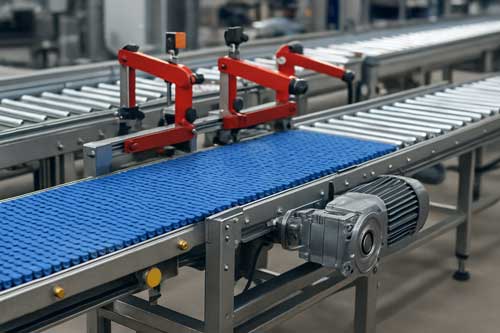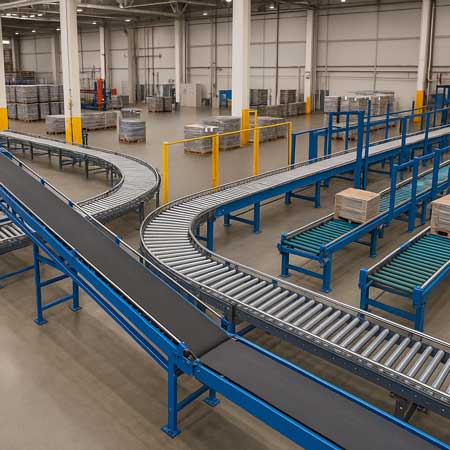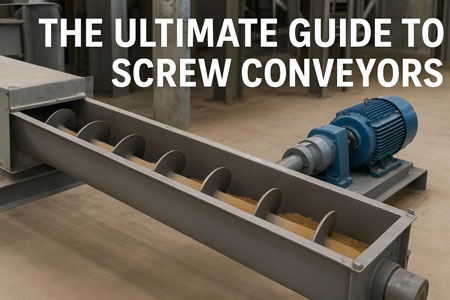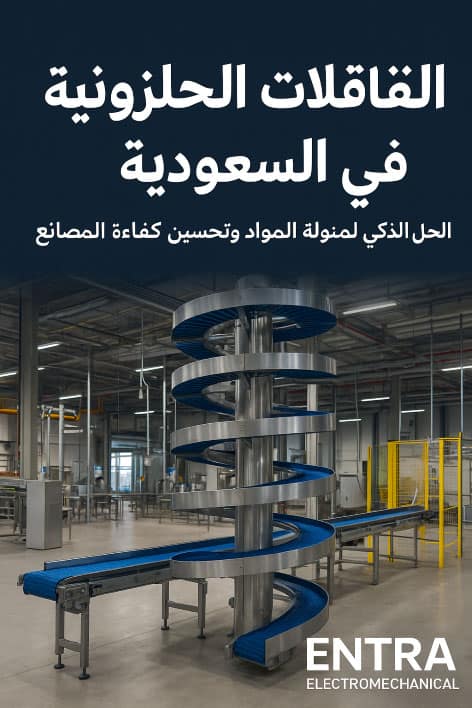
Automation Trends Transforming Conveyor Systems in 2025
August 7, 2025
What to Consider When Choosing Material Handling Solutions in Egypt
August 17, 2025A Comprehensive Guide to Boosting Efficiency and Safety

Conveyor layout design is a strategic project that directly impacts productivity, cost, safety, and long-term flexibility in any industrial facility. A well-planned material handling system transforms it from a potential bottleneck into a true competitive advantage.
Before placing any conveyor, objectives must be clearly defined: what target throughput levels, takt time, and service levels must the plant achieve? This simple question frames every subsequent decision regarding the selection of appropriate conveyor systems, their routes, how to temporarily store products, and the necessary material handling equipment – such as belt conveyors or pallet handling conveyors – to achieve key performance indicators (KPIs).
In this guide, I will provide a practical, step-by-step approach to conveyor layout design that production managers, industrial engineers, procurement teams, and plant operations leads can apply. These steps cover data collection, product profiling, industrial conveyor selection, route planning, adding conveyor accessories, automation planning with Programmable Logic Controllers (PLCs) and Warehouse Management Systems (WMS), testing with digital twins, commissioning, and planning for maintenance and expansion.
Data Collection and Process Mapping: The Solid Foundation
Begin by collecting accurate data and mapping current processes. Walk the plant floor with operators and supervisors, documenting every touchpoint where parts or inbound materials are handled. Measure current cycle times, idle times, hand-offs, and the frequency of rework or product damage. Record Stock Keeping Unit (SKU) sizes, weights, and package shapes.
This information directly impacts your choice between belt conveyors, roller conveyors, or chain conveyors. Capture environmental constraints such as cleanroom zones, cold storage, or corrosive atmospheres. Also note the locations of utilities, column positions, and fire escape corridors; these physical constraints determine where long conveyor runs can extend.
Dedicate time to mapping existing forklift paths, because conveyor routes that obstruct forklifts will create safety problems or require expensive rerouting. This early mapping phase also highlights opportunities for creating short conveyor loops, automated sortation points, or direct-to-pallet flows that eliminate repetitive material handling.
Product Profiling: Understanding Transport Requirements
Product profiling is the next essential step. Create a concise table of representative SKUs, listing dimensions, net and gross weight, fragility, stackability, and packaging type. These attributes tell you whether you should use belt conveyors for delicate packaged goods, roller conveyors for boxed parcels, or pallet handling conveyors for heavy loads.
For example, small, irregular packages often require belt conveyors with side guides and sensor-based tracking, while palletized loads demand heavy-duty chain-driven live roller systems that tolerate higher torque. Consider throughput per SKU; high-volume SKUs may justify dedicated lanes or higher-speed automated conveyor systems. Product temperature or hygiene requirements must also be considered; material handling solutions for food and pharmaceuticals will need sanitary belts and Clean-in-Place (CIP)-compatible conveyor accessories.
Choosing Conveyor Technologies and Preliminary System Architecture
Once requirements and product characteristics are clear, it’s time to choose conveyor technologies and preliminary system architecture. Determine which processes will be automated and which will remain manual to maintain flexibility. Typical best practice is to automate repetitive, high-volume transports – such as packing to palletizing, palletizing to warehouse staging, and case-to-case sortation – while keeping low-volume or highly variable tasks manual. Select industrial conveyors accordingly: belt conveyors are versatile and ideal for continuous flows and staging; roller conveyors are suitable for stable, flat-bottomed cartons; chain conveyors are rugged for heavy loads; and overhead or monorail conveyors save floor space for special flows.
Pallet handling conveyors should be included where full pallets move between packaging, stretch wrapping, and loading docks. Consider modular conveyor systems for flexibility, allowing reconfiguration as production changes.
Detailed Plant Floor Layout: Efficient Paths and Safe Spaces
Lay out the plant floor in detail. Start with a scaled CAD drawing or BIM model. First, place process blocks – receiving, inspection, production cells, assembly, testing, packaging, palletizing, and shipping. Then, route conveyor lines between these blocks following simple rules: keep routes as straight and short as possible; minimize sharp turns and elevation changes; place accumulation zones near bottlenecks; and separate inbound from outbound flows to avoid cross-traffic.
Design buffers and accumulation conveyors at work centers to decouple upstream and downstream variability. For example, use powered accumulation with zero-pressure zones for fragile items to prevent product damage. Include staging lanes for pallet handling conveyors near docks to speed truck loading. Always reserve maintenance aisles and safety clearances, and keep emergency exits unobstructed. When in doubt, choose more space for service access; cramped conveyors lead to costly maintenance shutdowns.
Integrating the Right Conveyor Accessories: Solutions for Operational Problems
Next, integrate the right conveyor accessories. These accessories are not luxuries; they are solutions to persistent operational pain points. Choose belt cleaners and scrapers to reduce carryback, which minimizes belt wear and improves cleanliness. Add skirtboards and seals at transfer points to control dust and spillage.
Use belt tracking systems and self-aligning idlers to prevent mistracking. Integrate photoelectric sensors, presence detectors, and speed encoders for precise control. For high-speed sortation, select motorized diverters, pushers, and servo-driven sorters.
Include safety devices – such as emergency stops, pull cords, safety cages, and interlocked gates – according to local regulations and ISO standards. For pallet flows, include turntables, pallet dispensers, and transfer cars to handle lane switching and multi-aisle movement. These conveyor accessories enhance uptime and protect workers, while also enabling more efficient material handling solutions.
Control Architecture and Integration Planning: Smart Material Handling Systems
Plan control architecture and integration early. Determine whether each conveyor segment will be controlled by local Programmable Logic Controllers (PLCs), by a plant-wide SCADA system, or by a hybrid model. For automated conveyor systems, robust PLC logic is vital; it handles queuing, indexing, diverter timing, and safety interlocks.
Integrate weight scales, barcode and RFID readers, and sensors with your Warehouse Management System (WMS) or Enterprise Resource Planning (ERP) system for real-time inventory accuracy and to support order picking or traceability.
For advanced systems, include edge devices and Internet of Things (IoT) telemetry for predictive maintenance – such as vibration sensors on motors and rollers, temperature monitors for drives, and runtime counters for bearings. Ensure that the network topology supports deterministic communications for safety I/O and that cybersecurity measures are in place for all connected material handling equipment.
Simulation: Validating Conveyor Layout Before Implementation
Simulation is a powerful tool to validate the conveyor layout. Use a digital twin or discrete-event simulation to model throughput, identify choke points, and validate accumulation logic. Simulation allows you to test peak-load scenarios and failure cases such as a downstream conveyor fault or a jam at a transfer zone.
Experiment with different buffering strategies and verify that pallet handling conveyors don’t create unexpected congestion at loading docks. Simulate how automated conveyor systems respond to make-or-break scenarios and refine PLC sequences accordingly. The time spent in simulation avoids expensive rework after installation.
Practical Options for Motors and Drives: Efficiency and Power
Make practical choices for drives and motors. Match motor sizes to expected loads, including worst-case dynamics like starting a fully loaded pallet. For extended long runs, consider distributed drives to reduce belt slip and improve energy efficiency.
For belt conveyors, choose appropriate belt materials (PVC, PU, rubber, or modular plastic) according to product needs – food-grade belts for edible products and heat- or chemical-resistant belts for heavy industry. Select drive pulleys with proper lagging for traction and specify motor starters or Variable Frequency Drives (VFDs) for soft starts and variable speed control. Energy-efficient drives and regenerative braking options in automated conveyor systems can reduce operational cost over time.
Safety and Ergonomics: Designing for Security and Comfort
Safety and ergonomics are closely integrated with layout design. Identify pinch points, roller nip zones, and areas where workers interact with conveyors. Provide adequate guard rails, safety signage, and ergonomic loading heights. For manual transfer areas, design workstations with lift-assist to reduce strain.
Ensure emergency stops and pull cords are visible and accessible, and interlock gates to disable conveyors during service. Implement lockout-tagout procedures and train maintenance teams on safe procedures. Remember: a safe layout is a reliable layout; fewer accidents mean fewer unexpected stoppages and better overall productivity.
Procurement Strategy: Securing Critical Components
Procurement strategy is paramount. Purchase critical long-lead components early – such as motors, Programmable Logic Controllers (PLCs), and custom rollers – while standard modules can be ordered later.
If you are using custom-engineered sections like pallet handling conveyors or transfer cars, secure dimensions and tolerances with your vendor. Standardize on prefabricated modules wherever possible to speed installation and ensure spare parts compatibility.
Negotiate service level agreements for preventive maintenance and spare parts supply, especially for conveyor accessories and electronic control components. For local support and faster lead times in the MENA region, consider working with suppliers like ENTRA Electromechanical who provide local engineering, fabrication, and service.
Installation Sequencing: A Precise Plan for a Smooth Process
Installation sequencing deserves its own plan. Install mainline conveyors first, then add accumulation lanes and sortation equipment. Route cables and Ethernet in dedicated trays to avoid mechanical damage. Ensure accurate squaring and alignment of frames to prevent belt drift.
Commission each conveyor section separately: verify belt tracking, motor tuning, sensor calibration, and safety interlocks. After isolated testing, perform integrated testing: run items through the entire production flow under realistic loads. Use test scripts that include failover cases – simulating a downstream fault, manual stop, or sensor failure – and validate that PLC logic maintains safety and recovers gracefully.
Training and Documentation: Ensuring Efficient Operation and Maintenance
Training and documentation are crucial for the success of a conveyor system. Prepare clear Standard Operating Procedures (SOPs) for operators and maintenance staff. These procedures should include startup and shutdown sequences, daily checks, belt tensioning procedures, lubrication schedules, and emergency response.
Create wiring diagrams, PLC logic documentation, and spare parts lists. Train staff on basic troubleshooting, and provide escalation paths for complex electrical or mechanical issues to the integrated party. Regular training reduces human error and improves response time, maintaining production stability.
Maintenance Planning: A Proactive and Predictive Approach
Maintenance planning should be proactive and predictive. Schedule daily visual checks and weekly basic tasks such as roller cleaning and belt inspection. Use sensor data from automated conveyor systems for condition-based maintenance: vibration spikes, increased motor temperature, or unusual current draw can predict imminent failure.
Keep critical spare parts – such as rollers, belts, bearings, and sensors – on-site to minimize Mean Time to Repair (MTTR). Track maintenance metrics like MTTR and Mean Time Between Failures (MTBF) to measure health and optimize schedules.
Performance Measurement After Commissioning: Continuous Monitoring and Improvement
After commissioning, regularly measure performance. Define Key Performance Indicators (KPIs) such as throughput (units/hour), Overall Equipment Effectiveness (OEE) for conveyor-fed lines, mean time between stoppages, and labor hours per unit moved.
Use dashboards that combine PLC telemetry and Warehouse Management System (WMS) data to provide immediate situational awareness. Continuous improvement cycles should be systematic: collect data, analyze bottlenecks, and iterate on conveyor accessory settings, buffer sizes, or PLC thresholds.
Scalability and Flexibility: Designing for the Future
Plan for scalability and flexibility from the outset. Use modular conveyors, standard frame heights, and quick-connect fittings for electrical and pneumatic lines. Leave space for future lanes or pallet station expansion. For plants with seasonal demand, modularity allows temporary reconfiguration to meet peak throughput. Consider design features that facilitate conversion between belt conveyors and roller lanes in multi-purpose facilities.
Financial Justification: Calculating Return on Investment
Financial justification completes the loop. Prepare a Return on Investment (ROI) model that includes capital cost, installation, reduced labor, fewer product damages, lower energy consumption, and maintenance savings. In many cases, automated conveyor systems pay back within 12-24 months due to labor savings and increased throughput. Include sensitivity analysis for utilization rates and labor cost volatility, and use conservative assumptions to avoid surprises.
Compliance and Standards: Ensuring Regulatory Adherence
Compliance and standards cannot be ignored. Ensure that your conveyor layout meets local electrical codes, machinery safety directives, and industry standards such as ISO and ANSI where applicable. Consider equipment certifications for food-contact materials or explosion-proof components if the environment demands it. Work with experienced integrators who are familiar with local regulations and can secure the necessary approvals.
Conclusion: Designing an Effective Conveyor Layout
In summary, designing a conveyor layout is an iterative and multidisciplinary task. It blends a practical understanding of materials, plant constraints, and process flows with the thoughtful selection of conveyor systems, conveyor accessories, and automated conveyor systems where they make the greatest impact. The right approach begins with data collection and process mapping, followed by product profiling and simulation, and concludes with measured commissioning, maintenance planning, and continuous improvement. By designing with flexibility, safety, and serviceability in mind, your facility gains a material handling solution that scales with production and supports long-term operational excellence.




